8 Resource Optimization Techniques Your Team Will Thank You For
Discover eight powerful resource optimization techniques to boost your team’s productivity and efficiency in this comprehensive guide.
Resource optimization is the foundation of a high-performing team. It’s about using time, money, talent, and tools effectively to achieve goals with minimal waste. When executed well, resource optimization boosts productivity, reduces costs, and keeps your team motivated. This comprehensive guide explores eight practical techniques to transform how your team operates, ensuring projects run smoothly and deliver maximum value. By focusing on resource allocation and resource management, these strategies will help your organization thrive while fostering a workplace where your team feels valued.
Why Resource Optimization Matters
Resource optimization ensures that every asset, from human capital to technology, is used to its fullest potential. Poor resource allocation can lead to missed deadlines, budget overruns, and employee burnout. In contrast, effective resource management improves efficiency, fosters collaboration, and drives long-term success. Research indicates that organizations prioritizing resource optimization can reduce project costs by up to 20% while improving delivery timelines.
By implementing the techniques below, you’ll maximize resources, keep your team engaged, and achieve better outcomes. Let’s explore the strategies.
8 Proven Resource Optimization Techniques
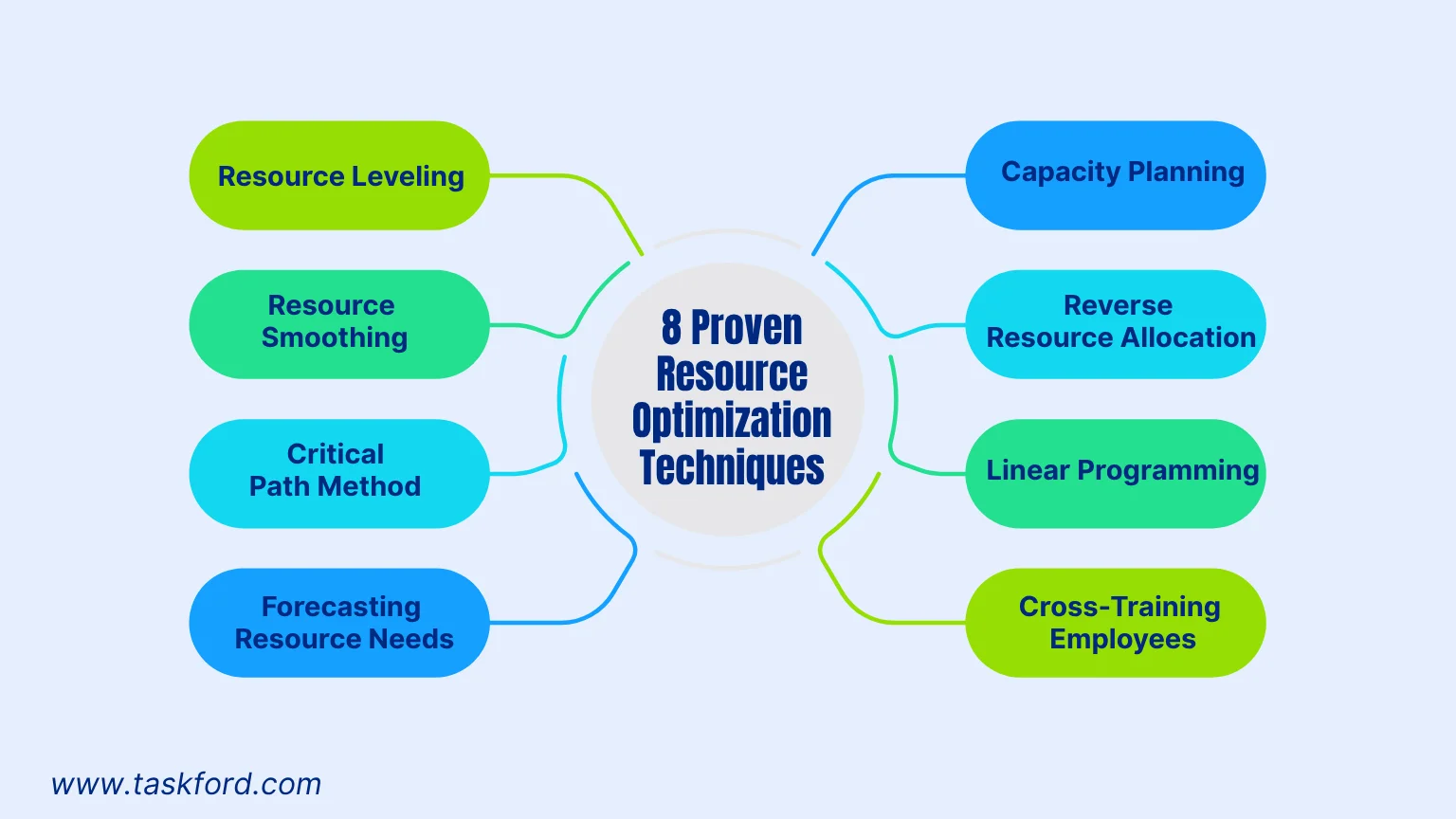
1. Resource Leveling
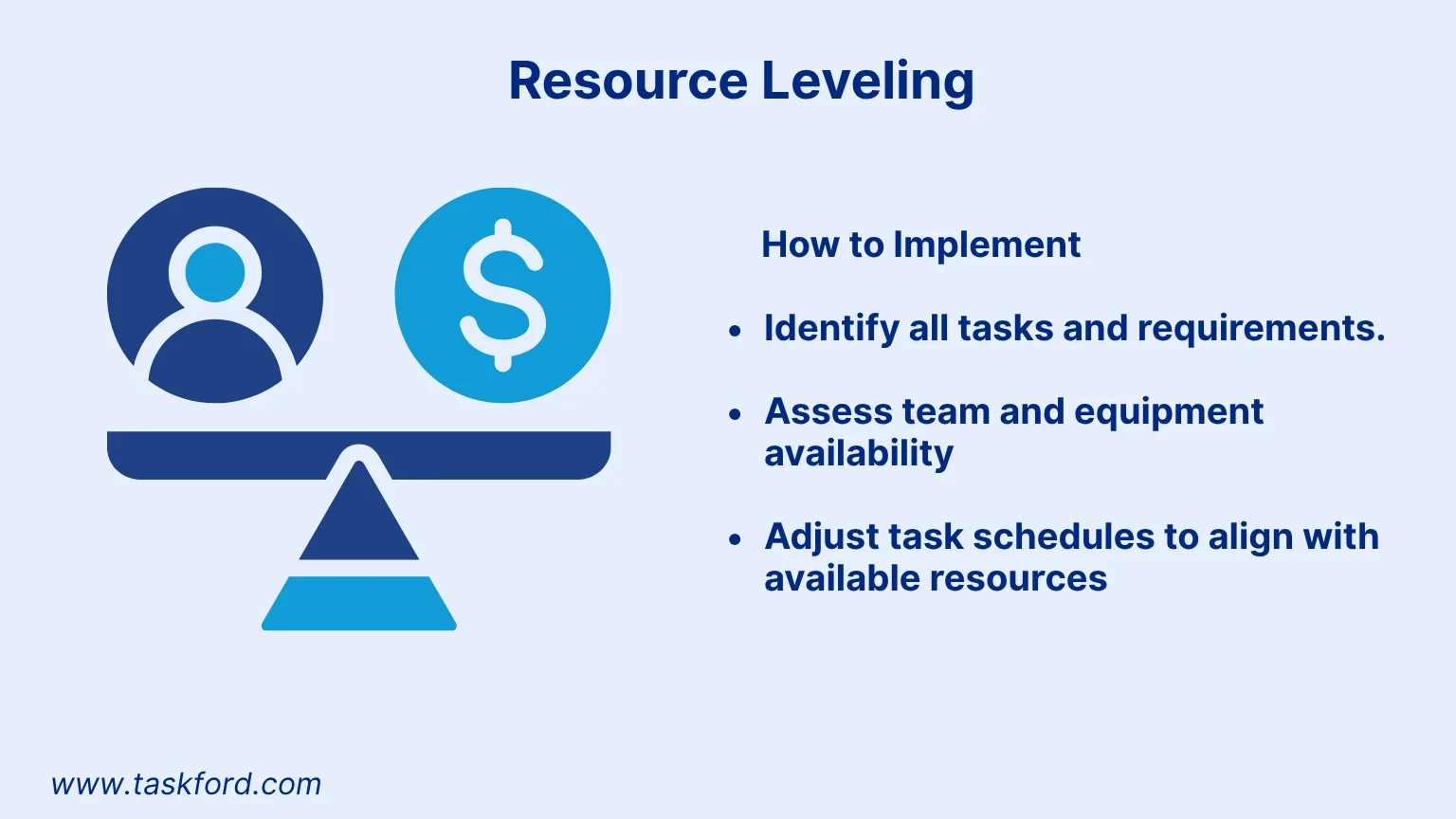
Resource leveling adjusts task start and finish dates to balance resource demand with availability, preventing over-allocation. This technique ensures team members and equipment are used efficiently without exceeding capacity, maintaining project quality and timelines.
How to Implement It:
- Identify all project tasks and their resource requirements.
- Assess team and equipment availability using resource planning tools.
- Adjust task schedules to align with available resources, delaying non-critical tasks if needed.
- Monitor progress to avoid resource conflicts.
Benefits:
-
Reduces burnout by balancing workloads.
(Learn more: How To Reduce Burnout On A Project)
-
Prevents resource shortages or overuse.
-
Maintains project schedules without compromising quality.
For example, in a construction project, resource leveling can ensure machinery and labor are scheduled to avoid downtime, optimizing resource allocation.
2. Resource Smoothing
Resource smoothing, or time-constrained scheduling, optimizes resource use within fixed project deadlines. It redistributes tasks to avoid overloading resources while staying within budget and timeline constraints, ensuring efficient resource management.
How to Implement It:
- Map out project tasks and deadlines.
- Analyze team workloads to identify peaks in resource demand.
- Redistribute tasks or add resources to balance workloads without altering deadlines.
- Use software to track resource usage in real time.
Benefits:
- Ensures timely project delivery.
- Minimizes resource overuse within constraints.
- Enhances cost efficiency.
For instance, a software development team might redistribute coding tasks to avoid overburdening developers, ensuring the project meets its deadline.
3. Critical Path Method (CPM)

The Critical Path Method (CPM) identifies the longest sequence of dependent tasks that determines a project’s minimum completion time. By prioritizing these critical tasks, you ensure resources are allocated to high-impact activities, optimizing project schedules.
How to Implement It:
- List all project tasks and their dependencies.
- Estimate task durations and map the critical path using a network diagram.
- Allocate resources to critical tasks first to avoid delays.
- Regularly review the critical path to adjust for changes.
Benefits:
- Focuses resources on tasks that drive project completion.
- Reduces delays by identifying bottlenecks early.
- Improves project planning accuracy.
For example, in a product launch, CPM ensures marketing and production tasks are prioritized to meet release dates, optimizing resource allocation.
4. Forecasting Resource Needs
Forecasting uses data to predict future resource requirements, enabling proactive resource allocation. By anticipating demand, you avoid shortages or excess capacity, ensuring resources are used efficiently across projects.
How to Implement It:
- Analyze historical project data and market trends.
- Use predictive analytics tools for accurate demand forecasts.
- Plan resource allocation based on projected needs.
- Update forecasts regularly to reflect changes.
Benefits:
- Prevents resource shortages or surpluses.
- Aligns resources with strategic goals.
- Enhances budget planning.
A retail business might forecast inventory needs for a holiday season, ensuring stock levels meet demand without overstocking, optimizing financial resources.
5. Capacity Planning
Capacity planning assesses team and resource availability to ensure tasks are assigned based on current and future capacity. This technique prevents overwork and underutilization, supporting efficient resource management.
How to Implement It:
- Evaluate team skills and availability.
- Use capacity planning tools to match tasks to available resources.
- Plan for future projects to avoid resource conflicts.
- Adjust plans based on real-time capacity data.
Benefits:
- Balances workloads to maximize productivity.
- Identifies staffing or equipment gaps early.
- Supports long-term project planning.
For example, an IT firm can use capacity planning to assign developers to projects based on their availability, ensuring efficient resource allocation.
6. Reverse Resource Allocation
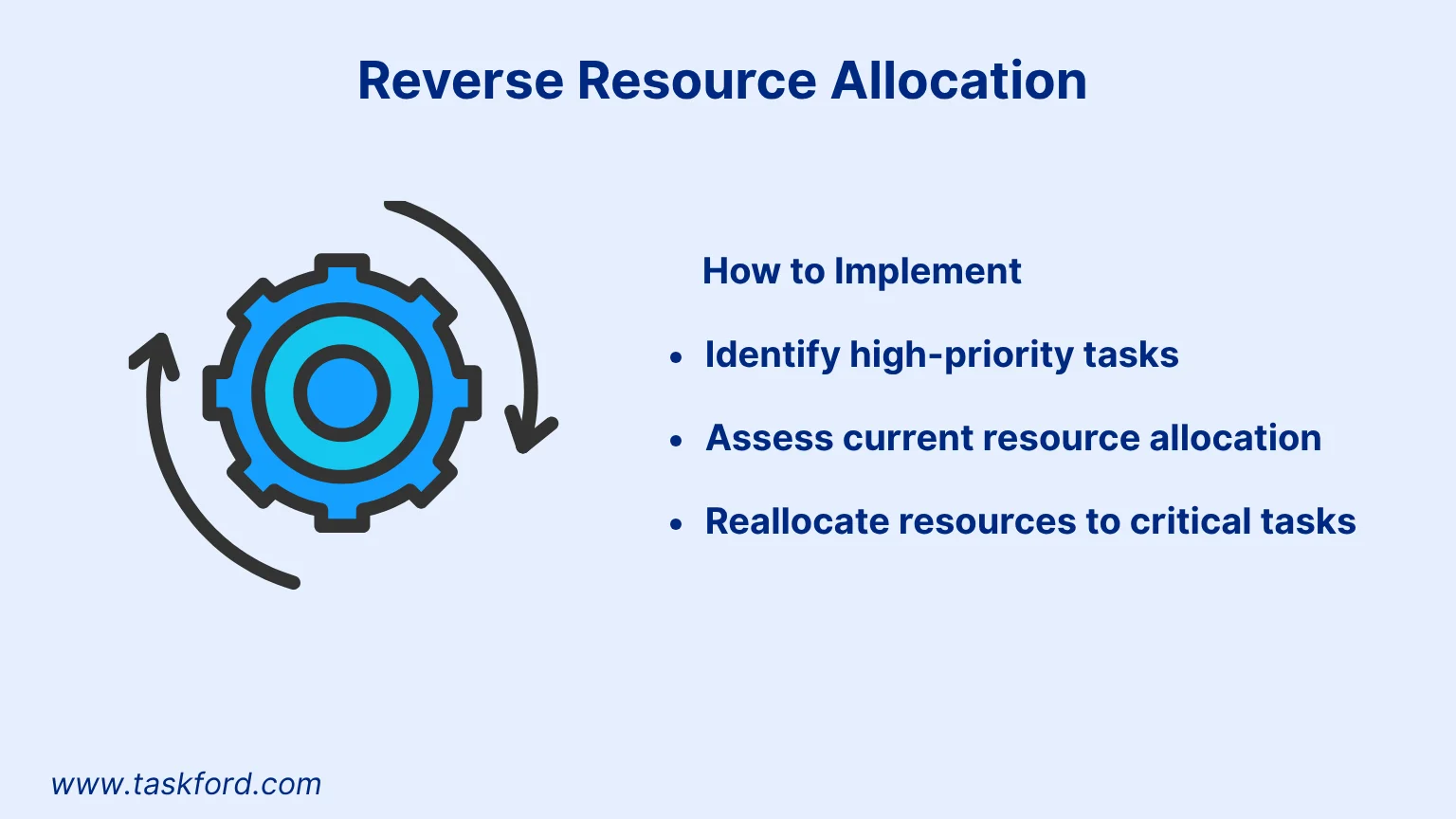
Reverse allocation reallocates resources from lower-priority or non-critical tasks to high-priority tasks when constraints arise, ensuring critical project goals are met. This technique optimizes resource use by dynamically adjusting allocations based on real-time needs.
How to Implement It:
- Identify high-priority tasks using methods like CPM.
- Assess current resource allocations and pinpoint underperforming or low-priority tasks.
- Reallocate resources (e.g., staff, budget) to critical tasks.
- Monitor project progress to ensure reallocation supports goals.
Benefits:
- Prioritizes critical project outcomes.
- Adapts quickly to resource constraints.
- Enhances flexibility in resource management.
For example, during a product launch, a team might shift marketing resources from a secondary campaign to the main launch to meet tight deadlines, ensuring optimal resource allocation.
7. Linear Programming
Linear programming uses mathematical models to optimize resource allocation by balancing constraints like budget, time, and capacity. This technique ensures resources are distributed to maximize efficiency and achieve project goals.
How to Implement It:
-
Define project objectives and constraints (e.g., budget, time).
(Learn more: Triple Constraint of Project Management)
-
Use linear programming software to create optimization models.
-
Allocate resources based on model outputs.
-
Monitor outcomes and adjust models as needed.
Benefits:
- Maximizes resource efficiency within constraints.
- Supports complex decision-making.
- Reduces costs through optimized allocation.
For instance, a logistics company might use linear programming to optimize delivery routes, minimizing fuel costs and time.
8. Cross-Training Employees
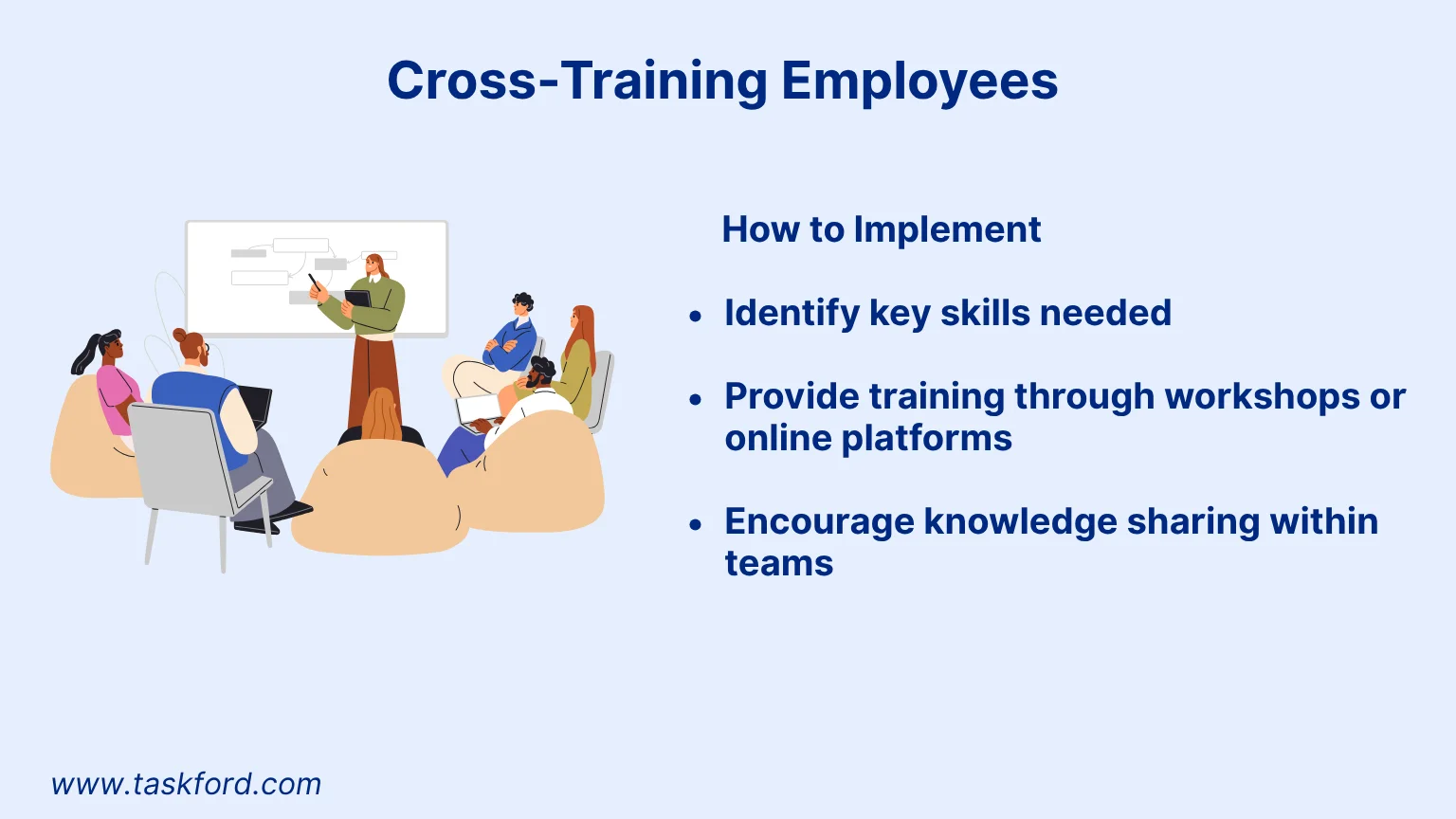
Cross-training equips employees with skills to perform multiple roles, increasing workforce flexibility. This technique reduces dependency on specialized staff and enhances resource allocation by enabling team members to fill various roles as needed.
How to Implement It:
- Identify key skills needed across projects.
- Provide training through workshops or online platforms like Coursera.
- Encourage knowledge sharing within teams.
- Monitor cross-training impact on project flexibility.
Benefits:
- Increases team versatility and resilience.
- Reduces hiring costs for specialized roles.
- Boosts employee engagement through skill development.
A customer support team cross-trained in social media management can handle inquiries across platforms, optimizing human resources.
Best Practices for Effective Resource Optimization
To maximize the impact of the above techniques, follow these best practices to ensure sustainable and effective resource management:
- Involve Your Team Early. Engage team members in planning resource allocation to gain buy-in and uncover practical insights. For example, asking employees about their workload capacity can prevent burnout and improve task assignments.
- Communicate Clearly. Share resource optimization goals and processes with your team to align everyone. Regular updates via team meetings or tools like Slack keep everyone informed and engaged.
- Balance Efficiency and Well-Being. Avoid over-optimizing, which can lead to stress or reduced quality. Schedule downtime and encourage breaks to maintain team morale and productivity.
- Stay Flexible. Markets and priorities shift, so adapt resource allocation as needed. For instance, a sudden client demand might require reallocating team members temporarily to meet deadlines.
- Invest in Continuous Improvement. Regularly review and refine your resource management processes. Conduct quarterly assessments to identify new tools or training opportunities that enhance efficiency.
These best practices ensure your resource optimization efforts are practical, inclusive, and sustainable, leading to long-term success.
How TaskFord Supports Resource Optimization
TaskFord enhances resource planning and management with three key features that align with the techniques above, ensuring efficient resource allocation and balanced workloads:
-
Capacity Planning: TaskFord’s capacity planning feature evaluates team availability and skills, enabling task assignments that prevent overwork or underutilization, supporting techniques like resource leveling and capacity planning.
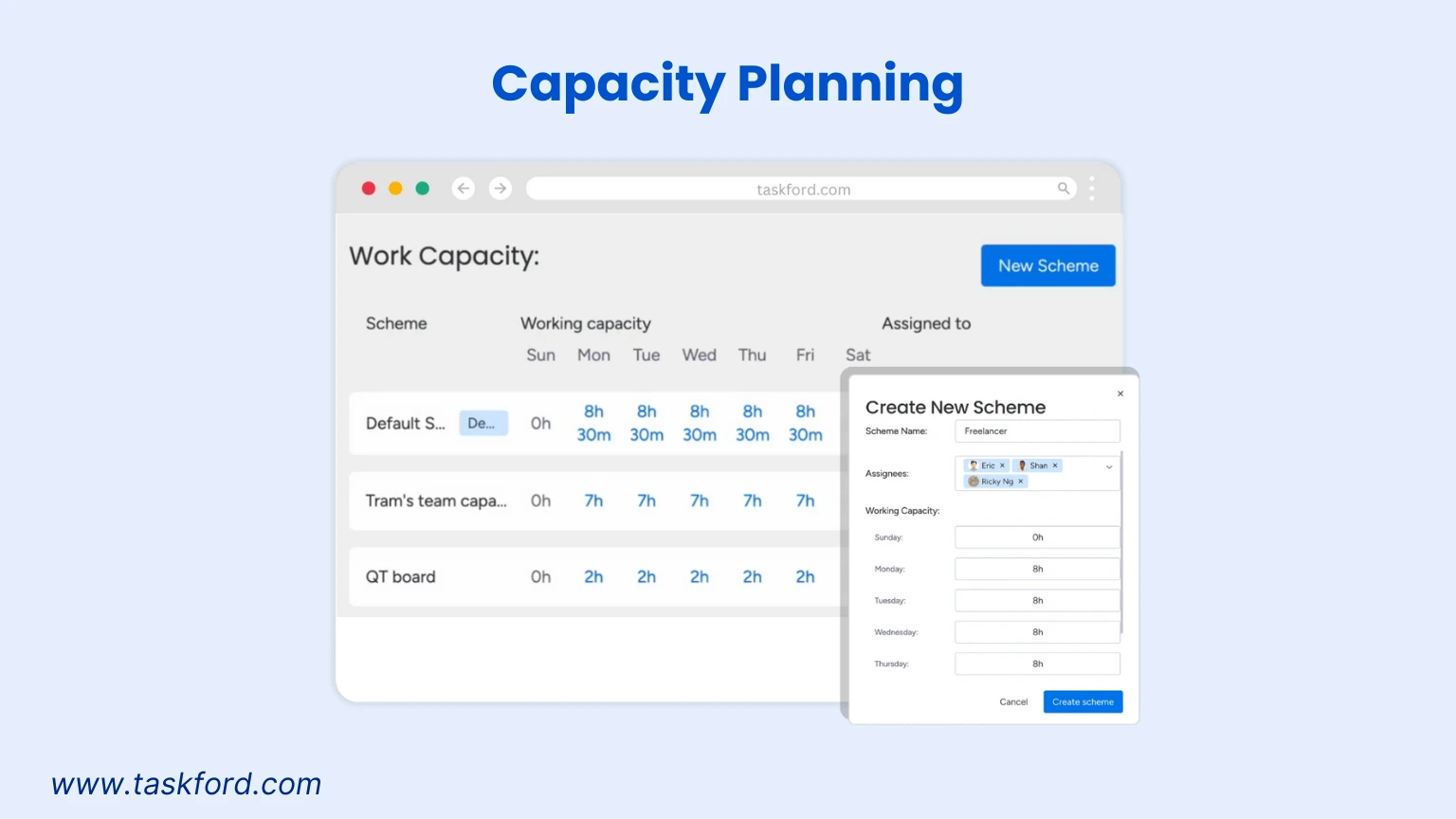
-
Workload Management: With real-time workload insights, TaskFord helps distribute tasks evenly, aligning with resource smoothing and cross-training by ensuring team members are not overburdened.
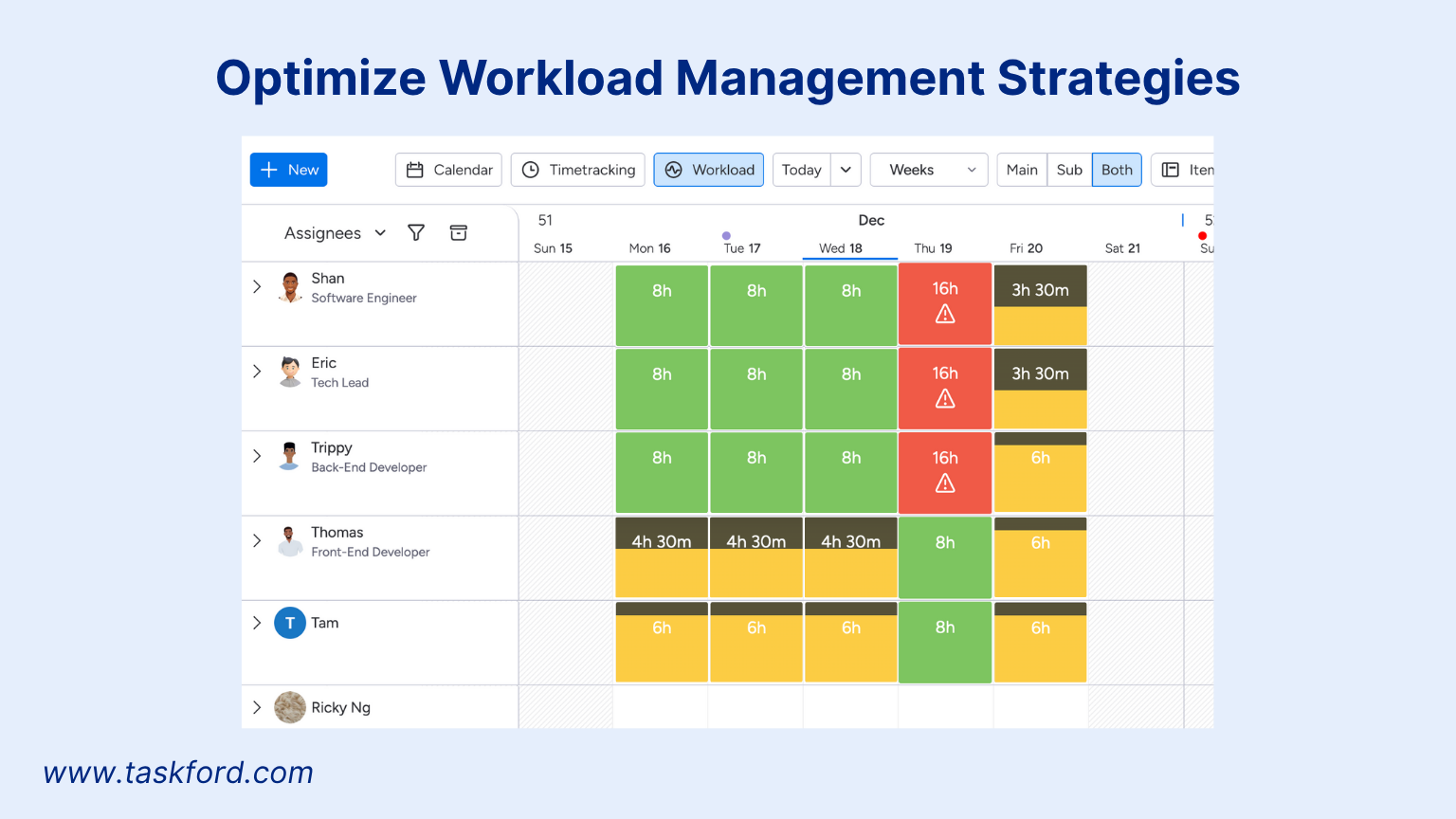
-
Resource Allocation: TaskFord’s resource allocation feature enables precise assignment of people, tools, and budgets to tasks based on project priorities and availability, using intuitive drag-and-drop scheduling and real-time tracking.

These features provide clear visibility and control, helping teams optimize resources effectively and making sure TaskFord stands out among other platforms such as Asana and Trello.
Overcoming Common Resource Optimization Challenges
Resource optimization can face obstacles. Here are common challenges and solutions:
-
Challenge: Resistance to change. Team members may resist new tools or processes.
- Solution: Communicate benefits clearly and involve the team in decisions.
-
Challenge: Lack of visibility. Without data, optimizing resources is difficult.
- Solution: Use analytics tools to track resource usage.
-
Challenge: Over-optimization. Excessive focus on efficiency can cause burnout.
- Solution: Balance optimization with employee well-being.
Addressing these challenges ensures sustainable resource optimization.
The Long-Term Benefits of Resource Optimization
These eight techniques, combined with best practices, create a culture of efficiency and accountability. Your team will appreciate reduced stress, clearer priorities, and better tools for success. Over time, effective resource management leads to:
- Increased productivity and profitability.
- Improved employee morale and retention.
- Greater adaptability to market changes.
Conclusion: Start Optimizing Today
Resource optimization empowers your team to do their best work with available resources. By implementing these eight techniques and following best practices, you’ll improve resource allocation, enhance resource management, and set your team up for success. Start with one or two strategies, like creating a resource allocation matrix or conducting a resource audit, and build from there. The result will be a more efficient, motivated team ready to tackle any challenge.
For more insights on resource optimization and how TaskFord can support your efforts, explore our platform’s tools and resources designed to maximize your team’s potential. Let’s make every resource count.
Learn more
- How To Use A Critical Path Calculator for Accurate Project Scheduling
- Unlocking Success In 2025 With The Right Resource Allocation Software
- Resource Management Explained: Key Definition, Must-Know Terms & Proven Techniques
Subscribe for Expert Tips
Unlock expert insights and stay ahead with TaskFord. Sign up now to receive valuable tips, strategies, and updates directly in your inbox.